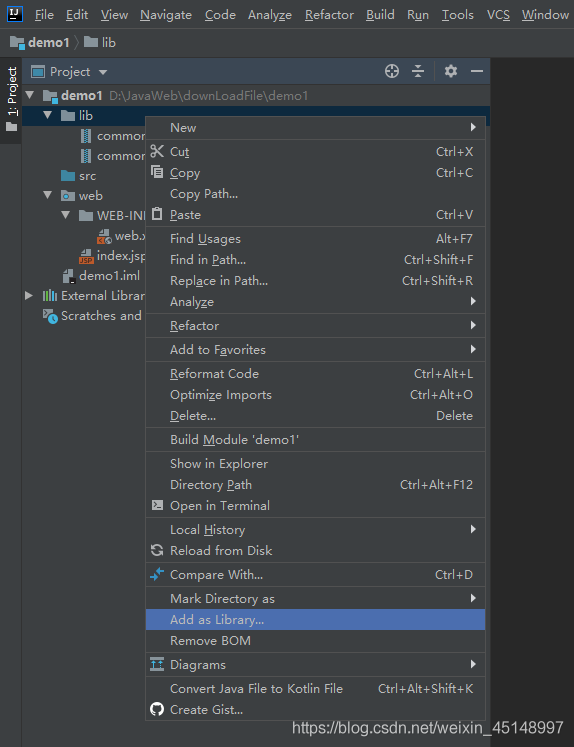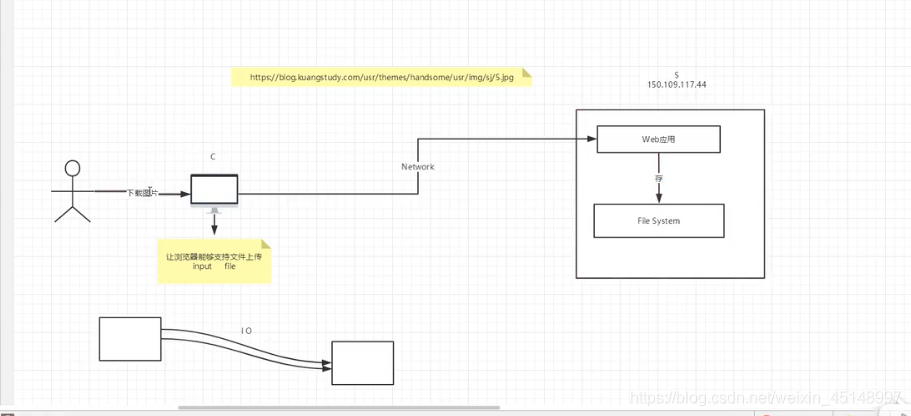JAVA文件传输原理及介绍
1.搭建环境(不使用Maven)

2.导入必要的包
在根目录下创建lib,maven库下载jar包并导入
https://mvnrepository.com/artifact/commons-io/commons-io
https://mvnrepository.com/artifact/commons-fileupload/commons-fileupload
3.文件上传原理

可以打开cmd,ping域名获得域名对应公网IP地址
4.上传文件调优

为避免同名图片的出现可以使用MD5加密还有uid,时间戳等等
5.代码解析
package cn.csn.servlet;
import org.apache.commons.fileupload.FileItem;
import org.apache.commons.fileupload.FileUploadException;
import org.apache.commons.fileupload.ProgressListener;
import org.apache.commons.fileupload.disk.DiskFileItemFactory;
import org.apache.commons.fileupload.servlet.ServletFileUpload;
import javax.servlet.ServletException;
import javax.servlet.annotation.WebServlet;
import javax.servlet.http.HttpServlet;
import javax.servlet.http.HttpServletRequest;
import javax.servlet.http.HttpServletResponse;
import java.io.File;
import java.io.FileOutputStream;
import java.io.IOException;
import java.io.InputStream;
import java.util.List;
import java.util.UUID;
@WebServlet(name = "FileServlet")
public class FileServlet extends HttpServlet {
private static final long serialVersionUID = 1L;
protected void doPost(HttpServletRequest request, HttpServletResponse response)
throws ServletException, IOException {
// TODO Auto-generated method stub
// response.getWriter().append("Served at: ").append(request.getContextPath());
// 判断上传的文件普通表单还是带文件的表单
if (!ServletFileUpload.isMultipartContent(request)) {
return;//终止方法运行,说明这是一个普通的表单,直接返回
}
//创建上传文件的保存路径,建议在WEB-INF路径下,安全,用户无法直接访间上传的文件;
String uploadPath =this.getServletContext().getRealPath("/WEB-INF/upload");
File uploadFile = new File(uploadPath);
if (!uploadFile.exists()){
uploadFile.mkdir(); //创建这个月录
}
// 创建上传文件的保存路径,建议在WEB-INF路径下,安全,用户无法直接访问上传的文件
String tmpPath = this.getServletContext().getRealPath("/WEB-INF/tmp");
File file = new File(tmpPath);
if (!file.exists()) {
file.mkdir();//创建临时目录
}
// 处理上传的文件,一般都需要通过流来获取,我们可以使用 request, getInputstream(),原生态的文件上传流获取,十分麻烦
// 但是我们都建议使用 Apache的文件上传组件来实现, common-fileupload,它需要旅 commons-io组件;
try {
// 创建DiskFileItemFactory对象,处理文件路径或者大小限制
DiskFileItemFactory factory = getDiskFileItemFactory(file);
/*
* //通过这个工厂设置一个缓冲区,当上传的文件大于这个缓冲区的时候,将他放到临时文件 factory.setSizeThreshold(1024 *
* 1024); //缓存区大小为1M factory.setRepository (file);//临时目录的保存目录,需要一个File
*/
// 2、获取ServletFileUpload
ServletFileUpload upload = getServletFileUpload(factory);
// 3、处理上传文件
// 把前端请求解析,封装成FileItem对象,需要从ServletFileUpload对象中获取
String msg = uploadParseRequest(upload, request, uploadPath);
// Servlet请求转发消息
System.out.println(msg);
if(msg.equals("文件上传成功!")) {
// Servlet请求转发消息
request.setAttribute("msg",msg);
request.getRequestDispatcher("info.jsp").forward(request, response);
}else {
msg ="请上传文件";
request.setAttribute("msg",msg);
request.getRequestDispatcher("info.jsp").forward(request, response);
}
} catch (FileUploadException e) {
// TODO 自动生成的 catch 块
e.printStackTrace();
}
}
public static DiskFileItemFactory getDiskFileItemFactory(File file) {
DiskFileItemFactory factory = new DiskFileItemFactory();
// 通过这个工厂设置一个缓冲区,当上传的文件大于这个缓冲区的时候,将他放到临时文件中;
factory.setSizeThreshold(1024 * 1024);// 缓冲区大小为1M
factory.setRepository(file);// 临时目录的保存目录,需要一个file
return factory;
}
public static ServletFileUpload getServletFileUpload(DiskFileItemFactory factory) {
ServletFileUpload upload = new ServletFileUpload(factory);
// 监听长传进度
upload.setProgressListener(new ProgressListener() {
// pBYtesRead:已读取到的文件大小
// pContextLength:文件大小
public void update(long pBytesRead, long pContentLength, int pItems) {
System.out.println("总大小:" + pContentLength + "已上传:" + pBytesRead);
}
});
// 处理乱码问题
upload.setHeaderEncoding("UTF-8");
// 设置单个文件的最大值
upload.setFileSizeMax(1024 * 1024 * 10);
// 设置总共能够上传文件的大小
// 1024 = 1kb * 1024 = 1M * 10 = 10м
return upload;
}
public static String uploadParseRequest(ServletFileUpload upload, HttpServletRequest request, String uploadPath)
throws FileUploadException, IOException {
String msg = "";
// 把前端请求解析,封装成FileItem对象
List<FileItem> fileItems = upload.parseRequest(request);
for (FileItem fileItem : fileItems) {
if (fileItem.isFormField()) {// 判断上传的文件是普通的表单还是带文件的表单
// getFieldName指的是前端表单控件的name;
String name = fileItem.getFieldName();
String value = fileItem.getString("UTF-8"); // 处理乱码
System.out.println(name + ": " + value);
} else {// 判断它是上传的文件
// ============处理文件==============
// 拿到文件名
String uploadFileName = fileItem.getName();
System.out.println("上传的文件名: " + uploadFileName);
if (uploadFileName.trim().equals("") || uploadFileName == null) {
continue;
}
// 获得上传的文件名/images/girl/paojie.png
String fileName = uploadFileName.substring(uploadFileName.lastIndexOf("/") + 1);
// 获得文件的后缀名
String fileExtName = uploadFileName.substring(uploadFileName.lastIndexOf(".") + 1);
/*
* 如果文件后缀名fileExtName不是我们所需要的 就直按return.不处理,告诉用户文件类型不对。
*/
System.out.println("文件信息[件名: " + fileName + " ---文件类型" + fileExtName + "]");
// 可以使用UID(唯一识别的通用码),保证文件名唯
// 0UID. randomUUID(),随机生一个唯一识别的通用码;
String uuidPath = UUID.randomUUID().toString();
// ================处理文件完毕==============
// 存到哪? uploadPath
// 文件真实存在的路径realPath
String realPath = uploadPath + "/" + uuidPath;
// 给每个文件创建一个对应的文件夹
File realPathFile = new File(realPath);
if (!realPathFile.exists()) {
realPathFile.mkdir();
}
// ==============存放地址完毕==============
// 获得文件上传的流
InputStream inputStream = fileItem.getInputStream();
// 创建一个文件输出流
// realPath =真实的文件夹;
// 差了一个文件;加上翰出文件的名产"/"+uuidFileName
FileOutputStream fos = new FileOutputStream(realPath + "/" + fileName);
System.out.println("path:"+realPath + "/" + fileName);
// 创建一个缓冲区
byte[] buffer = new byte[1024 * 1024];
// 判断是否读取完毕
int len = 0;
// 如果大于0说明还存在数据;
while ((len = inputStream.read(buffer)) > 0) {
fos.write(buffer, 0, len);
}
// 关闭流
fos.close();
inputStream.close();
msg = "文件上传成功!";
fileItem.delete(); // 上传成功,清除临时文件
//=============文件传输完成=============
}
}
return msg;
}
}
版权声明:本文为weixin_45148997原创文章,遵循CC 4.0 BY-SA版权协议,转载请附上原文出处链接和本声明。